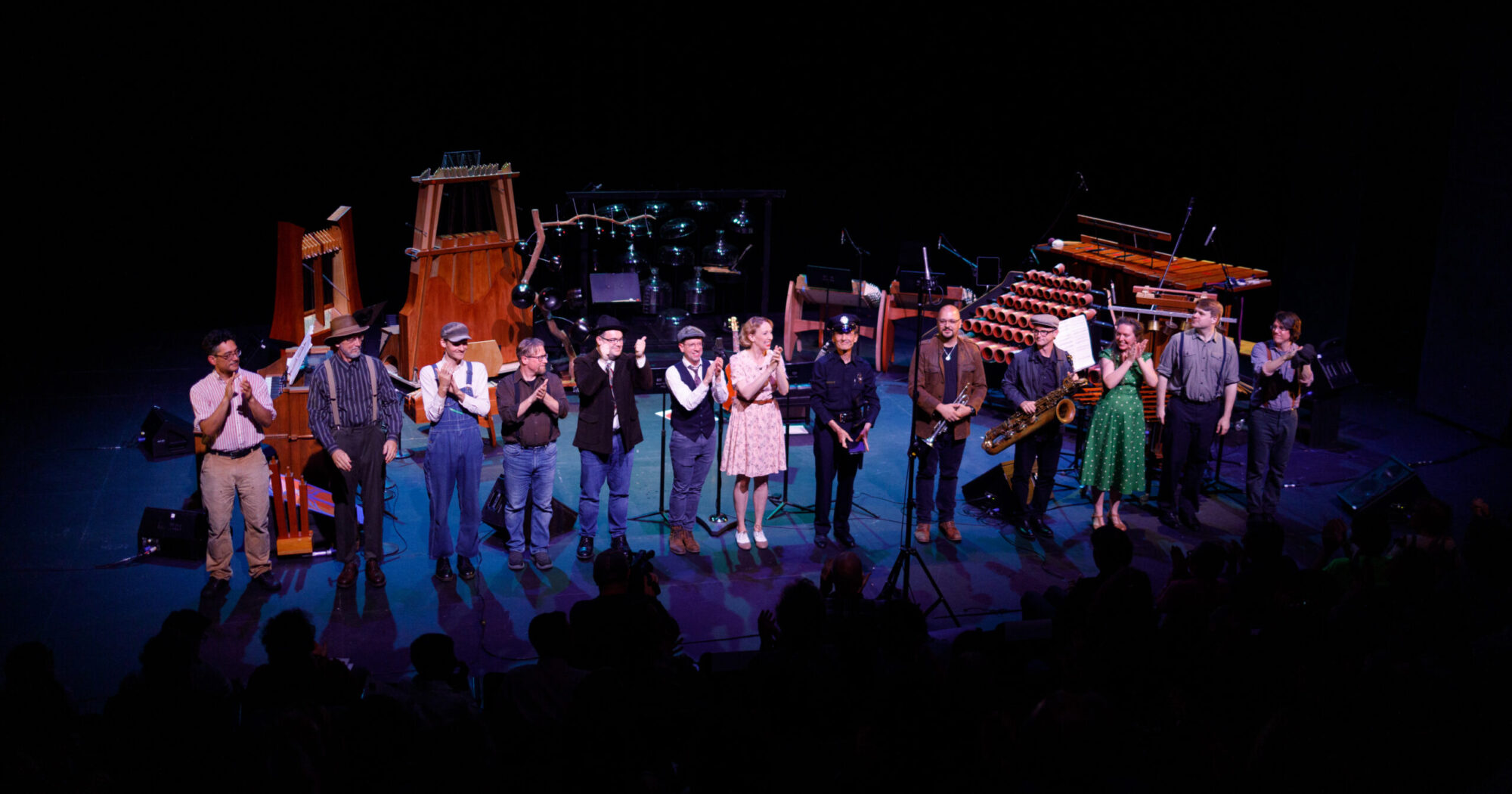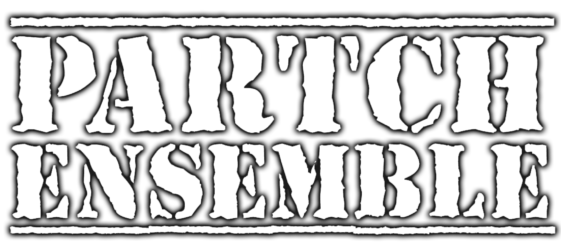re-Genesis of a Music
~ A tale of obsession ~
by John Schneider
Part V: Adapted Guitar II
By 1998, I had decided that there was no turning back (see Part IV), as the search for a deeper understanding of Partch’s music had already begun in earnest. With the successful construction of the Adapted Guitar I, followed by performances, a recording, and very enthusiastic audience response, I felt absolutely compelled to continue down that path. I wanted more… But what next? Of course! There were at least three different guitars in Partch’s history, and I had only explored one.
Having finally decided that I must reconstruct the 10-string Adapted Guitar II, I was facing all sorts of hurdles. So many questions! It turns out that Genesis of a Music, Partch’s essential book first published in 1949 with a second expanded Edition in 1972, not only serves as an extraordinary music theory primer, hidden history of music, and autobiography— it’s also a cookbook. The ingredients needed to recreate his marvelous instruments can be found in those pages: tantalizing recipes with most of the details intact, though certainly not all, as I was about to find out. Luckily, Partch supplied a photograph for each instrument, and the Adapted Guitar II was no exception.
Sure enough, the exotic fingerboard was there all right, with what was basically a wooden ruler on the treble side that was evidently covered with the ratios of just intonation. But they were completely illegible. AND the fingerboard itself was with covered with an amazing pattern what were supposed to be colored triangles, according to the written description. But it was a black & white photo! Sigh. I would just have to visit the original.
That would have been a lot easier back when I first met the instruments in 1977, when they were still living in San Diego under the supervision of Danlee Mitchell, Partch’s assistant for the last twenty years of his life. But now they were back East and in the care of Dean Drummond & his group Newband, who had been performing and recording with them since their arrival for a spectacular performance of Revelation in the Courthouse Park at Philadelphia’s American Music Theatre Festival in 1987 (recorded on Tomato Records TOM 3004). Sadly, I didn’t have the budget or time to make the necessary pilgrimage east to examine those mysterious colored triangles, but luckily, I happened upon this announcement:
Newband presents “Harry Partch and His Legacy”
Thursday, Sept. 23, 1999 at 8 p.m. at Yerba Buena Center;
Tickets are $13-15. Partch instruments will be on display Sept. 21-23
Now that I could manage, Yerba Buena being in San Francisco. So I booked a flight, bought a ticket, and wrote to Dean to arrange some private time with the instruments before the performance.
My, what a strange instrument this was! Originally a 6-string Oahu brand ‘squareneck’ Hawaiian guitar, this version had ten strings, and the craziest headstock I’d ever seen. When Partch adapts an instrument, it seems like everything changes. In order to add those four extra strings, he attached a set of four connected mandolin tuners to the top of the newly designed tuning head, and made a custom bridge & nut that were much wider than the original, suspending two bass strings & two treble strings over either side of the original fingerboard. And then, there were those triangles:
So I took lots of pictures & measurements, bringing them home to figure out what it was all about.
As Partch had discussed in Genesis, the triangles are colored to correspond with the Chromelodeon Color Analogy, assigning the six different colors of the rainbow spectrum to each of the six harmonic overtones of his just intonation Hexads:
1…………..red = root, or fundamental
3…………..orange = 3rd harmonic above the fundamental = perfect 5th
5…………..yellow = 5th harmonic above the fundamental = Major 3rd
7…………..green = 7th harmonic above the fundamental = minor 7th
9…………..blue = 9th harmonic above the fundamental = Major 9th
11…………orange = 11th harmonic above the fundamental = Octave + tritone
Ratios would be represented by two colors, since an interval is the relationship between two different pitches. The pure Major 3rd G-B, for example, is described numerically by the ratio 5/4, which is the distance between the 5th harmonic and the 4th. The 4th harmonic is the G two octaves above the fundamental, and would be represented by RED, while the 5th harmonic is the B a major third above that, represented by YELLOW. Thus, to find a 5/4 on a particular string, the guitarist slides the plexiglass rod to the base of a triangle that is colored YELLOW/RED.
Suddenly, it all made sense, as the actual colors were the Rosetta Stone that made the possibility of making an accurate copy the instrument a reality.
But why there were two continuous lines of Isosceles triangles, touching apex to base all the way from the nut to the soundhole? And why were the patterns different? There was only one set of ratios on the ‘ruler,’ which were in the correct order, but they only corresponded to some of the note/triangles in the lower row, not the upper! (Guess I’ll have to ask Partch next time I see him, since Genesis certainly never said why.) What the heck: just copy them, and figure that out later.
Next question: what instrument should I use? I suppose I could try to find a 1930’s Oahu (they were actually manufactured by Kay guitars for the Oahu Publishing Company of Cleveland, Ohio that was riding the huge wave of Hawaiian music’s popularity). Partch’s creative tuning head would be a challenge to make, but not insurmountable. But I remembered the instrument being very hard to handle because of those extra strings hanging over both sides of the neck, the exact place a player hands onto when carrying the guitar on & off stage, let alone removing it from its case. Hmmm…its case…the original had no case, and maybe that’s why! Very impractical.
Ten strings, eh? Wait a minute, there already exist 10-string lap steel guitars that are played in exactly the same way. Perhaps there are acoustic versions? Nope—very rare, so that’s out. 10-string Pedal or Lap steel guitars I could find, but they were all solid body electrics: the sound would be all wrong—another dead end. So instead making a ten-stringer by adding four strings to a six string guitar (6+4=10), I decided to go the other way: get a twelve string guitar, and take two strings off (12-2=10), and that would also fit in a premade guitar case. Hello, Ebay…
When my 1975 Martin D-12-28 arrived, it went straight to Greg Brandt’s shop, where he removed the frets, and laboriously ground down the Ebony fingerboard to a quarter of its original height, polishing the surface to ready it for the triangles to come. He also copied the original bridge, and replacing the initial six pairs with ten equally spaced holes:
Off to the hobby store to buy six little glass bottles of Testor’s Enamel Paint in red, orange, yellow, green, blue, & violet. Time to paint the triangles! It took almost a month to paint the dozens & dozens of triangles, as each tiny triangle needed a day or so to dry before I could safely use the masking tape to paint those that abutted it.
In the end, there were 142 of them, and as you can see by the patterns, some were monochrome (black = secondary ratios) or two-tone (primary ratios), while some were subdivided into four parts. Several were divided into 14 tiny triangles in 7 separate colors, indicating that the 1/1 G note that it could function as the root, 3rd, 5th, 7th, 9th, or 11th of various different tonalities:
Mind you, those 142 triangles only described the pitches produced on some of the strings, the lower chain of compound triangles showing the notes for the 3rd, 7th & 9th strings that were all tuned to F (16/9), while it turned out that the upper line revealed the pitch identities found on the 5th, 7th, and 10th strings that were three octaves of C (4/3):
[low ] C – F – C – F – Ab – C – Eb – F – F# – Gb [high]The plexiglass slide would then move to the base of the triangle (the widest part always on the right side from the player’s point-of-view) to produce the wanted pitch:
But what if he wanted a note on one of the other four strings? Partch used a kind of tablature that showed which string to play, and where to put the slide using either the top line of triangles or the bottom, depending which tuning he was using. So the ratio in the score tells the performer where to put the slide, not the resultant pitch. In the opening of The Crane (1949), we learn that the guitar is tuned in the ‘minor’ or Utonality tuning that will use the lower row of triangles. The first guitar chord uses all ten strings strummed low to high, and the slide should be placed at the base of the multicolored triangle, indicated by the 1/1 on the white list of ratios on the New Adapted Guitar above:
The opening vocal note, however, was in fact an 11/9 on the 7th string, but the (20/11) below it also refers to where the slide would be if one was using the lower line of triangles. Hmmm. So in making my copy of the instrument, I added another row of ratios on the bass side of the strings to supplement those on the treble side as found on his ‘ratio ruler.’
It must also be remembered that not only did Partch’s Monophonic Scale have 43-tones to the octave, he actually used many more than that. And yet, this Adapted Guitar only has 14 triangles per octave. Why!? Simplicity, really. (He used the same concept on his Adapted Viola, marking only 29 notes out of 43, as we will see in an upcoming edition of PARTCHed.) The triangles are landmarks, but the performer must know where all of the ratios live between them. No small task!
This is, by the way, just one of the reasons that Partch’s music has remained such a mystery for all of these decades. The musicologists, composers, performers and critics that are tacitly responsible for carrying on traditions of the past have had an impossible task when confronted by two dozen unique tablatures for even more exquisitely singular instruments. But fear not—that is starting to change!
After all of the tiny triangles had dried on the new instrument, it was time to figure out what gauge strings to use, since the open strings went as low as the Cello C2 (~65Hz) up to F#4 (~370Hz) which meant a .076” mando-cello string for the lowest note down to a .009” for the highest:
Luckily, Partch himself had recorded the Three Intrusions—“The Crane” as well as two others called “The Rose” & “The Waterfall”—in 1950, so I knew exactly what the instrument should sound like. Tuned up and ready to go, a full year after I had first held Partch’s instrument in San Francisco, I hit that first chord…and it was exactly right:
I was thrilled – those haunting harmonies were finally there beneath my fingers, giving me shivers down my spine. There was only one problem…there was no music for solo Adapted Guitar II! In order to play those Three Intrusions (1949), I would need a marimba. And not just any marimba either, but one shaped like a Diamond…

